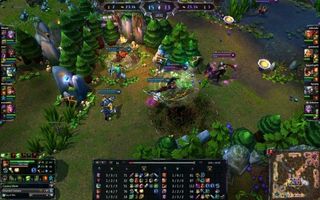League of Legends World Championships will be worth record-breaking $3 million
You've probably heard of a little game called League of Legends by now. 11.5 million people play it every month, and it's one of the hottest games in professional circles right now. Riot Games is adding fuel to the esport fire this week, with the addition of the new spectator mode that went live this morning and the announcement that this season's World Championships will offer the largest prize in esports history, three million dollars.
The prize pool is split between the World Championships, which will take place in Los Angeles this October, and the Regional Finals that lead up to the big crescendo, including an event at PAX Prime in Seattle. The global tournament will bring in professional teams from Chine, Europe, North America, Korea, Taiwan and Southeast Asia. It will cap off LoL's second season, which started in November 2011.
We had a chat with Riot's VP of esports, Dustin Beck to talk about how LoL's competitive scene is looking, how different teams around the world play the game and what champion he wants to see in the championship match in November.

PCG: 3 million dollars is a lot of money. What makes it possible to keep raising the ante each year with LoL's world championships? More players, more sponsors, or something else entirely?
Dustin Beck: As a game that was designed with eSports in mind from day one, the League of Legends competitive scene's been growing alongside the game itself. Players have been sharpening their skills and making it clear that they're interested in competing, and the community at large has voted with their eyeballs—over two million viewers tuned into each of the last three Challenger circuit events.
That's the motivation behind our commitment to eSports. The size of the prize pool, features like our enhanced spectator mode, and everything we do for competitive play—it's all to give the LoL eSports scene the support it deserves. We want it to be entertaining for fans, engaging for players at all levels of competitive play and a lucrative career choice for the best teams around the world.
PCG: Do the professional teams in the different regions have different tactics or prefer a certain type of playstyle over another?
The biggest gaming news, reviews and hardware deals
Keep up to date with the most important stories and the best deals, as picked by the PC Gamer team.
DB: That's actually one of the most exciting prospects about the World Championship. Last year, we saw some interesting interplay between the more aggressive styles of the European teams and the more defensive approach of North Americans. Teams like Moscow Five have changed the playstyle again, introducing incredibly aggressive invasion tactics which then spread from Europe to North America. Star players usually have a signature champion which can make their team compositions and tactics completely different, forcing teams from other regions to adapt their own playstyles on the fly.

PCG: What's one core strategy/tactic universal to everyone?
DB: Jungling is an approach that's pretty universal. At pro-level play in today's metagame, you'll basically always see a jungler. But even then, the execution can vary wildly, based on what champions a team picks to jungle, how aggressive they are with ganking, whether they counter-jungle, etc.
PCG: Are there any game rules or requirements that make the tournament environment different than what we play on live servers?
DB: We run tournaments on a special server that's only available for circuit competition. That server is sometimes one patch behind the live game, depending on timing. First, we might delay a patch due to come out mid-tournament from hitting the “Tournament Environment” until the tournament is over. Second, to ensure the pros have had a chance to adapt to the latest champion and live balance changes, we might not roll one out just before the tournament starts. Tournament games also have the capability to pause, in case there are any local network issues or other interruptions. Besides that, game rules within each specific match are exactly the same as a ranked game.
PCG: How many people play LoL professionally at this point?
DB: There's an amazing amount of competition going on in League of Legends eSports: we're seeing upwards of a thousand individual teams participating every week in Go4LoL tournaments, just one example of competition at the prized-events level of play.
There's somewhere around 200 elite players competing in Challenger Circuit events around the world, but that number is rising as more and more teams emerge onto the scene.

PCG: Who do you think will be the teams to beat?
DB: If you take a look at our standings on the League of Legends competitive site , you can see the NA and EU rankings, with some memorable names like CLG and TSM, and some relatively new upstarts like Moscow Five, who've been killing it. But then you have to remember teams like MiG in Korea and World Elite in China. There's a ton of amazing competition around the world, and honestly, it could be anyone's game. We can't wait to see where teams place in the finals to determine the twelve competitors in the World Finals.
PCG: Have you found that LoL players tend to root for teams from their home country, or for teams that use their personal favorite champions?
DB: There's definitely some regional or country pride. It's almost like watching the World Cup or Olympics in that sense. Like with other professional sports, there's also a ton of zeal for specific players and their personalities, especially if those pros are known for playing fans' favorite champions.
Even though we're only into Season Two, we're already seeing fans develop bonds for their favorite teams; we can expect that kind of fanaticism to escalate as we watch these amazing teams write their histories.

PCG: How many times have these teams had a chance to play professionally against international opponents?
DB: Nowadays, we're seeing pros competing regularly in scrimmage matches with other teams from around the world. Beyond that, different leagues and tournaments have different rules for international participation. Three Challenger Circuit leagues (Major League Gaming, the Intel Extreme Masters and IGN Pro League) allow teams from Europe and North America to compete against each other, for instance. But the World Championships will be the best place to see League of Legends international competition.
PCG: You have to make a prediction right now: name one player who'll play in the final match of the Regional Finals at USC's arena in October, and name one champion that'll be played in that match.
DB: With so many competitors, I don't think I could ever name a single player who I know will be in the final match of 10 pros. And since over 70 champions were picked and banned in one of the most recent Challenger Circuit events, it would be equally challenging to get that one right. But as a Ziggs fan, I hope we see Ziggs!
PCG: With Dota 2 coming strong out of the gates, and obviously looking to challenge LoL's claim to the esports throne, what is the most important thing Riot Games can do to improve League of Legends in the esports arena?
DB: We often say that we aim to be player-focused with every decision we make. We're constantly trying to give our players more and better stuff, and that includes not only what we're doing in eSports, but everything we do to evolve the MOBA genre. We're focused on supporting our players and fans more than what any of the other MOBA titles are doing.
The Season Two events we're announcing today and the big enhancements to Spectator Mode are great examples of what we're doing to foster a great eSports scene for League of Legends. We're constantly looking for more ways to do that, and we'd love to hear from players what else we can do to continue giving League of Legends eSports the support it deserves.
Most Popular






